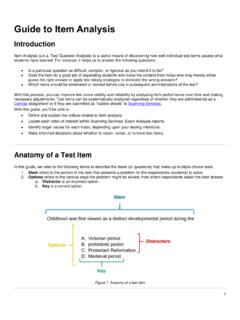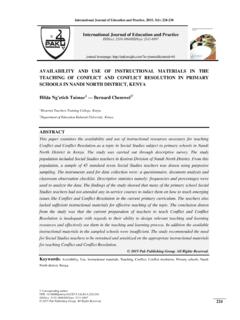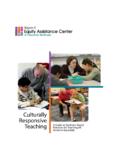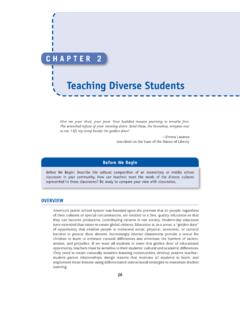Transcription of Inquiry-based Learning - Pennsylvania State University
1 Jill L. Lane Schreyer Institute for teaching Excellence Penn State 301 Rider Building University Park, PA 16802 7-15-2007 Inquiry-based Learning As faculty, we engage ourselves in inquiry throughout our academic careers when we explore questions and try to make sense out of what is going on in our fields. My guess is that most of us chose our field of study because one question, somewhere along the way, piqued our curiosity and motivated us to find an answer. A common question asked by faculty is, How can I motivate my students interest and get them excited about the subject they are studying? One way to do this is to give your students Inquiry-based assignments and activities that are relevant to their lives and future careers and give them the opportunity to engage in course concepts and tasks.
2 After reading the next few pages, you will learn more about Inquiry-based Learning (IBL) and along with some tips on effectively integrating IBL into your course. What is IBL? Inquiry-based Learning is a research- based strategy that actively involves students in the exploration of the content, issues, and questions surrounding a curricular area or concept. The activities and assignments in an IBL classroom can be designed such that students work individually or together to solve problems involving both in-class work and fieldwork. While the strategy is meant to be highly student-focused, the extent of teacher-directed vs. student-directed Learning can vary depending on the level of the students in your course and their understanding of the inquiry process.
3 The amount of faculty involvement in the process is explained in, Designing an instructional Plan, Activities, and Assignments, below. Why Use IBL? Other than increasing student motivation, one of the main reasons to think about using IBL in your course is because it provides a means to actively involve students in the Learning process. With the trend in higher education to move away from teacher-centered instruction to a more student-centered approach, IBL gives you the opportunity to help students learn the content and course concepts by having them explore a question and develop and research a hypothesis. Thus, giving students more opportunity to reflect on their own Learning , gain a deeper understanding of the course concepts in an integrated fashion, and become better critical thinkers.
4 Integrating inquiry into the Classroom The process for integrating inquiry into your course contains phases that are similar to those used in the design of any course: determining your goals and objectives; an analysis of your potential students (their experience, prior knowledge, and academic level); your role in the Learning process; developing an instructional plan; and designing activities, assignments, and assessments. As you proceed through each phase of the process, keep in mind that your teaching method (IBL) and all of the activities, assignments and assessments should be congruent with the goals and objectives for your course. Therefore, you need to continually revisit each phase as you go through the process, making sure that this congruency exists.
5 Stating Your Goals and Objectives Think of your course as an entire system of individual units and lessons. When you do this you ll realize that you not only have goals and objectives for the entire course, but also the individual units and lessons. Regardless of the part of the system, all of your goals and objectives should be related. If you decide to use IBL in your course, then two of your goals should be: 1) to have students become better problem solvers and critical thinkers and 2) to have your students engage in higher-order thinking skills. Beyond these, your goals should focus on what your students should know (concepts, principles, and rules) or be able to do (procedures and tasks) when they leave your course.
6 Analyzing Your Potential Students When you are designing a course for Inquiry-based Learning , you need to look at your students on two different dimensions. First, you need to consider the academic level of your students. That is, what do they already know about the concepts and procedures in your course. Have they taken any prerequisite courses? Do they have any real-world experiences that will help them understand the content in your course? Is there any other prior knowledge that they might possess? Second, you need to consider is the amount of experience they have doing inquiry or undertaking the research process? It is important in this analysis that you do not overestimate their experience because when you begin to plan your instruction, their level of experience will dictate the amount of structure and modeling you need to do in the beginning of the semester.
7 Determining Your Role in the Learning Process Even though IBL is considered a student-directed approach, if your course is the first time that your students encounter the inquiry process you will need to provide more structure early on in the semester. Too often, students experience frustration because the assignment is too difficult for their level and they do not know where to start. To avoid this dilemma, it helps to assume that the majority of your students are not ready to go solo: and provide them with prompts, cues, and a chance to watch you model the process for them. Designing an instructional Plan, Activities, and Assignments A large part of the faculty and student roles in an Inquiry-based course are dictated by the instructional plan you choose.
8 Bonstetter (1998) provides a guide for planning instructional (see Figure 1) that is based on the perceived knowledge, skills, and abilities of your students with respect to the inquiry process. Jill L. Lane Schreyer Institute for teaching Excellence Penn State 301 Rider Building University Park, PA 16802 7-15-2007 Traditional Structured Guided Student Directed Student Research Topic Teacher Teacher Teacher Teacher Teacher/ Student Question Teacher Teacher Teacher Teacher/ Student Student Materials Teacher Teacher Teacher Student Student Procedures/ Design Teacher Teacher Teacher/ Student Student Student Results/Analysis Teacher Teacher/ Student Student Student Student Conclusions Teacher Student Student Student Student Figure 1: From Bonstetter, (1998).
9 inquiry : Learning from the past with an eye on the future. Electronic Journal of Science Education, 3(1). To use this model effectively, it is best to identify your starting point for the semester. If your students have little or no experience with inquiry , then the Traditional column is the place to start. In this column, you are directing student Learning by modeling the entire inquiry -process. Once you feel that your students are ready, you can work your way through the structured, guided, etc. plans. The key in this planning guide is to recognize that as you progress through the semester, your involvement lessons becomes more as a facilitator and less as a director (see the appendix for an example of how one problem can be used in three different types of instructional plans).
10 Developing Assessments The best way to assess Inquiry-based assignments is to use a rubric (grading guide) that identifies the areas you want to assess and the criteria for different levels of achievement within each area. Rubrics take the mystery out of grading and help students understand what you are looking for as you grade the assignments. Final Thoughts In summary, Inquiry-based Learning is a method that can be used to actively engage students in an in-depth exploration of the concepts and skills associated with your course. The important thing to remember if you are going to adopt this strategy is to gauge how much experience and prior knowledge your students have doing Inquiry-based tasks so you can determine the amount of direction you need to give them.







